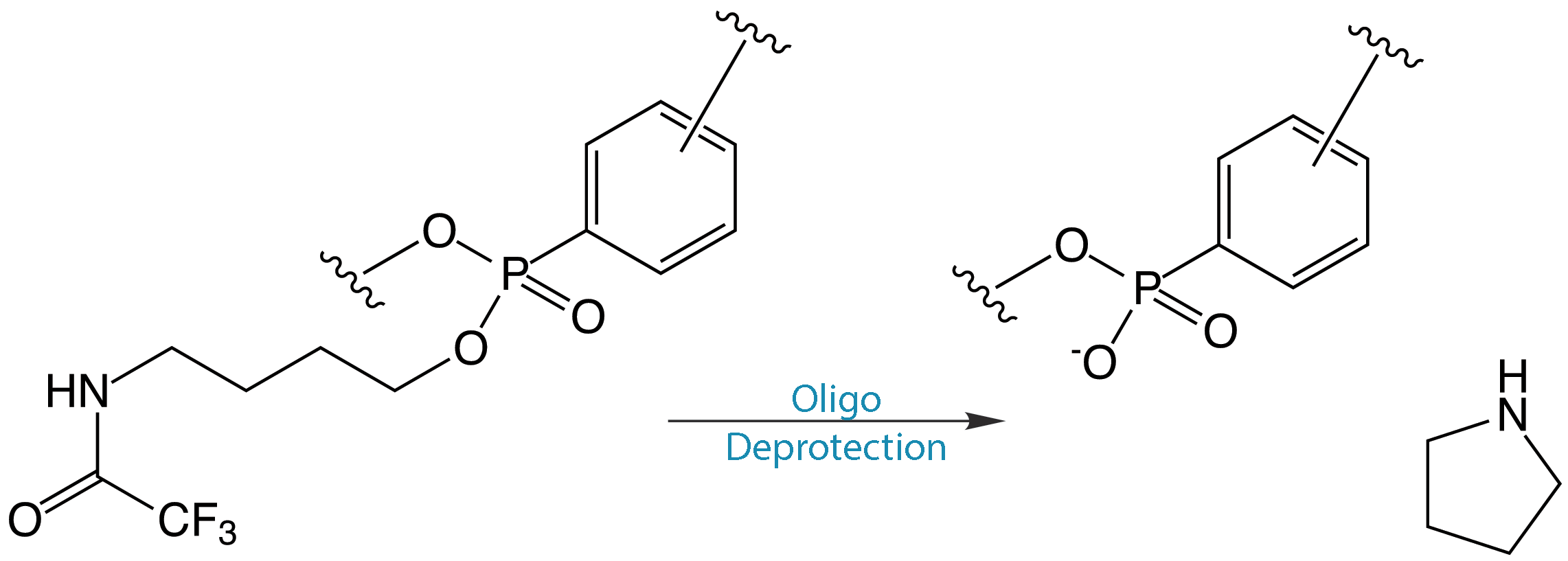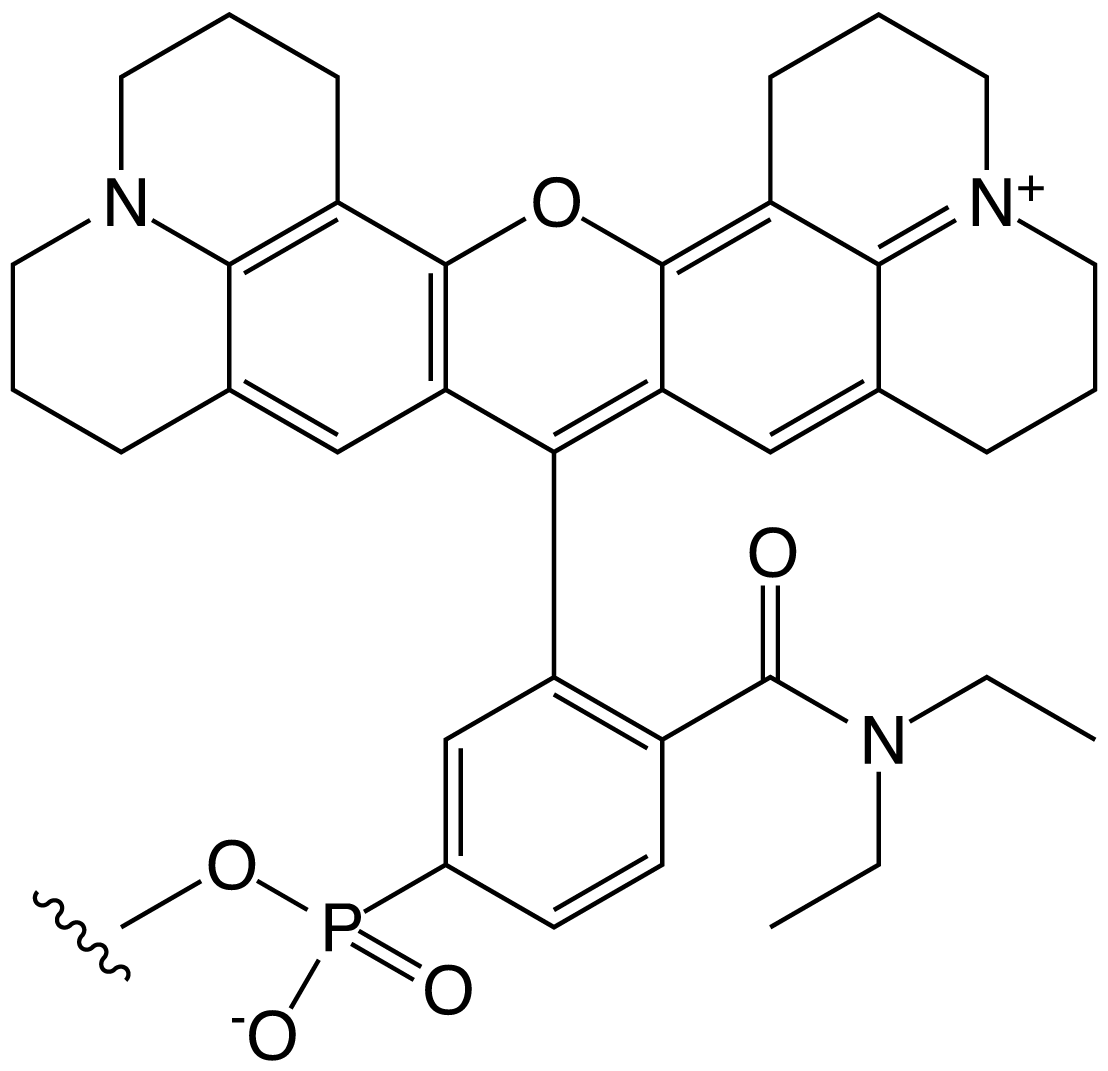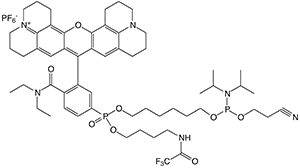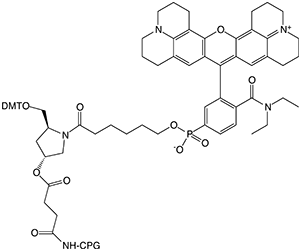Glen Research has been active in supplying fluorescent dyes for labelling oligonucleotides for close to 30 years. Indeed, fluorescent dyes are probably the most commonly used tags for modifying oligonucleotides since they offer such sensitive detection in a wide variety of techniques varying from sequencing to genetic analysis. We offer a broad range of fluorophores covering most of the fluorescence spectrum. However we have never had a good substitute for Texas Red® or Alexa Fluor® 594, both of which are not amenable to the conditions of oligonucleotide synthesis and deprotection.
Our long-term relationship with the Epoch Biosciences division of ELITechGroup has allowed us to evaluate several of their proprietary AquaPhluor® family of fluorescent dyes. AquaPhluor dyes have been developed to allow access to fluorophores containing large fluorescent aromatic heterocycles with their natural hydrophobicity substantially modulated by the presence of a charged phosphonate group in the molecule. For phosphoramidite chemistry, the latent phosphonate group is elegantly protected with a trifluoroacetamidobutyl (TFAAB) group, which is removed during base deprotection by a mechanism shown in Figure 1. The resulting negatively charged phosphate forms a hydrophilic zwitterion with the positively charged dye.

AquaPhluor® 593 (AP593) (1) has the properties which led us to believe that this fluorophore could be a good substitute for Texas Red®. It is a highly fluorescent molecule with an absorption maximum at 593nm and an emission maximum at 613nm. Its quantum yield is 0.6. The fluorescence of AquaPhluor® 593 is only weakly affected by pH, varying only a few percent in the range pH 5-8. In addition, the fluorescence of AquaPhluor® 593 only drops about 30% when heated from 20 °C to 95 °C.
We are delighted to offer 5’-AquaPhluor® 593 Phosphoramidite (2) and 3’-AquaPhluor® 593 CPG (3), the structures of which are shown in Figure 2.
Figure 2: AquaPhluor® 593, 5'-Phosphoramidite and 3'-CPG |
||
 |
 |
 |
1) AquaPhluor® 593 (AP593) |
(2) 5'-AquaPhluor® 593 Phosphoramidite |
(3) AquaPhluor® 593 CPG |
A 3 minute coupling time is recommended.
This support should be used in a manner identical to a normal protected nucleoside support since it contains the DMT group.
Oligonucleotides containing AquaPhluor® 593 can be deprotected using ammonium hydroxide with a few provisos. The following conditions gave excellent results:
However, the last more aggressive treatment led to a small amount of degradation of the dye.
It should be noted that an interesting side reaction of AquaPhluor® 593 was observed when using a fast-cleaving support, e.g., Glen UnySupport FC or a Q support. This side reaction leads to a non-fluorescent impurity. However, this impurity, formed only during deprotection with ammonium hydroxide using a fast cleaving support, can be eliminated using a pre-treatment with 10% diethylamine in acetonitrile for 2-3 minutes (Figure 3a).

Oligonucleotides containing AquaPhluor® 593 can be deprotected using AMA and no pre-treatment with a hindered base is required, as shown in Figure 3b.
5’-AquaPhluor® 593 is not sufficiently hydrophobic to be compatible with standard Glen-Pak purification protocols. However, a suitable, modified Glen-Pak™ purification protocol is being investigated. Please inquire.
We have demonstrated that AquaPhluor® 593 is a dye that is stable to the conditions of oligonucleotide synthesis and deprotection. Its emission fits nicely in the range of emission between Cyanine 3.5 and Cyanine 5 dyes. AquaPhluor® 593 is relatively insensitive to changes in pH in the range pH 5-8. In addition, the emission of AquaPhluor® 593 is not substantially quenched by raising the temperature from 20 - 95 °C. We have concluded that AquaPhluor® 593 is a dye with superior chracteristics and is indeed a viable alternative to Texas Red® and Alexa Fluor® 594.
We are happy to provide 5’-AquaPhluor® 593 Phosphoramidite and 3’-AquaPhluor® 593 CPG in collaboration with ELITechGroup.
This product is for research purposes only, and may not be used for commercial, clinical, diagnostic or any other use. The Product is subject to proprietary rights of ELITechGroup and is made and sold under license from ELITechGroup. There is no implied license for commercial use with respect to this Product and a license must be obtained directly from ELITechGroup. with respect to any proposed commercial use of this Product. "Commercial use" includes but is not limited to the sale, lease, license or other transfer of the Product or any material derived or produced from it, the sale, lease, license or other grant of rights to use the Product or any material derived or produced from it, or the use of the Product to perform services for a fee for third parties (including contract research). AquaPhluor® is a registered trademark of ELITechGroup.

Transient Cyanoethylation - an unexpected route to chemical bleaching of a fluorophore